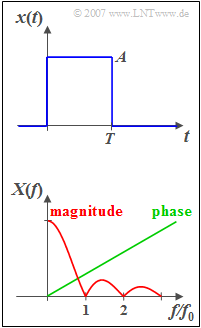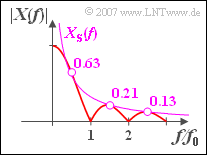Difference between revisions of "Aufgaben:Exercise 3.3: From the Signal to the Spectrum"
From LNTwww
| Line 54: | Line 54: | ||
</quiz> | </quiz> | ||
| − | === | + | ===Solution=== |
{{ML-Kopf}} | {{ML-Kopf}} | ||
| − | '''(1)''' | + | '''(1)''' With the abbreviation $\omega = 2\pi f$ the spectral function is according to the first Fourier integral: |
:$$X( f ) = \int_0^T {A \cdot {\rm{e}}^{-{\rm{j}}\omega t} \hspace{0.05cm}{\rm d}t = } \int_0^T {A \cdot \cos \left( {\omega t} \right)\hspace{0.05cm}{\rm d}t }\hspace{0.1cm}-\hspace{0.1cm} {\rm{j}} \cdot \int_{\rm{0}}^T {A \cdot \sin ( {\omega t} )} \hspace{0.05cm}{\rm d}t.$$ | :$$X( f ) = \int_0^T {A \cdot {\rm{e}}^{-{\rm{j}}\omega t} \hspace{0.05cm}{\rm d}t = } \int_0^T {A \cdot \cos \left( {\omega t} \right)\hspace{0.05cm}{\rm d}t }\hspace{0.1cm}-\hspace{0.1cm} {\rm{j}} \cdot \int_{\rm{0}}^T {A \cdot \sin ( {\omega t} )} \hspace{0.05cm}{\rm d}t.$$ | ||
| − | * | + | *After integration and insertion of the limits, it follows: |
:$${\mathop{\rm Re}\nolimits} [ {X( f )} ] = \frac{A}{\omega } \cdot \sin( {\omega T} ),$$ | :$${\mathop{\rm Re}\nolimits} [ {X( f )} ] = \frac{A}{\omega } \cdot \sin( {\omega T} ),$$ | ||
| Line 66: | Line 66: | ||
:$${\mathop{\rm Im}\nolimits} [ {X( f)} ] = \frac{A}{\omega } \cdot \left( {\cos ( {\omega T}) - 1} \right) = - \frac{A}{\omega } \cdot\left( {1 - \cos ( {\omega T} )} \right).$$ | :$${\mathop{\rm Im}\nolimits} [ {X( f)} ] = \frac{A}{\omega } \cdot \left( {\cos ( {\omega T}) - 1} \right) = - \frac{A}{\omega } \cdot\left( {1 - \cos ( {\omega T} )} \right).$$ | ||
| − | * | + | *For the frequency $f = 1/(2T) = 10\, \text{kHz}$ ⇒ $\omega \cdot T = \pi$ we get:: |
:$${\mathop{\rm Re}\nolimits}[{X( {f = 10 \;{\rm{kHz}}} )}] = \frac{A}{ {2{\rm{\pi }}f}} \cdot \sin ( {\rm{\pi }} ) \hspace{0.15 cm}\underline{= 0},$$ | :$${\mathop{\rm Re}\nolimits}[{X( {f = 10 \;{\rm{kHz}}} )}] = \frac{A}{ {2{\rm{\pi }}f}} \cdot \sin ( {\rm{\pi }} ) \hspace{0.15 cm}\underline{= 0},$$ | ||
| Line 73: | Line 73: | ||
| − | '''(2)''' | + | '''(2)''' The magnitude square is the sum of the real and imaginary parts, squared in each case: |
:$$\left| {X( f )} \right|^2 = \frac{ {A^2 }}{ {\omega ^2 }}\big[ {\sin ^2 ( {\omega T} ) + 1 - 2 \cdot \cos ( {\omega T}) + \cos ^2 ( {\omega T} )} \big].$$ | :$$\left| {X( f )} \right|^2 = \frac{ {A^2 }}{ {\omega ^2 }}\big[ {\sin ^2 ( {\omega T} ) + 1 - 2 \cdot \cos ( {\omega T}) + \cos ^2 ( {\omega T} )} \big].$$ | ||
| − | * | + | *Because of $\sin^2(\alpha) + \cos^2(\alpha) = 1$ , this can also be written: |
:$$\left| {X( f )} \right|^2 = \frac{ {2A^2 }}{ {\omega ^2 }} \cdot \big( {1 - \cos ( {\omega T} )} \big) = \frac{ {4A^2 }}{ {\omega ^2 }} \cdot \sin ^2( {\omega T/2} ).$$ | :$$\left| {X( f )} \right|^2 = \frac{ {2A^2 }}{ {\omega ^2 }} \cdot \big( {1 - \cos ( {\omega T} )} \big) = \frac{ {4A^2 }}{ {\omega ^2 }} \cdot \sin ^2( {\omega T/2} ).$$ | ||
| − | * | + | *Setting $\omega = 2\pi f$ and taking the root, we obtain, under the condition $A > 0$: |
:$$\left| {X( f )} \right| = \left| \frac{A}{ {\rm\pi }f} \cdot \sin ( {\rm \pi }fT ) \right| = A \cdot T \cdot \left| \frac{\sin ( {\rm\pi }fT )}{ {\rm \pi}fT} \right|.$$ | :$$\left| {X( f )} \right| = \left| \frac{A}{ {\rm\pi }f} \cdot \sin ( {\rm \pi }fT ) \right| = A \cdot T \cdot \left| \frac{\sin ( {\rm\pi }fT )}{ {\rm \pi}fT} \right|.$$ | ||
| − | * | + | *With the shortcut $\text{si}(x) = \sin(x)/x$ the result is: |
:$$\left| {X( f)} \right| = A \cdot T \cdot\left|{\rm si} ( { {\rm{\pi }}fT} ) \right|.$$ | :$$\left| {X( f)} \right| = A \cdot T \cdot\left|{\rm si} ( { {\rm{\pi }}fT} ) \right|.$$ | ||
| − | * | + | *The spectral value at the frequency $f = 1/T = \text{20 kHz}$ is given by |
:$$\left| {X( {f = 20\;{\rm{kHz}}} )} \right| = \frac{ {A \cdot T}}{ {\rm{\pi }}} \cdot \sin ( {\rm{\pi }} ) \hspace{0.15 cm}\underline{= 0}.$$ | :$$\left| {X( {f = 20\;{\rm{kHz}}} )} \right| = \frac{ {A \cdot T}}{ {\rm{\pi }}} \cdot \sin ( {\rm{\pi }} ) \hspace{0.15 cm}\underline{= 0}.$$ | ||
| − | * | + | *When calculating the value for $f = 0$ the quotient $\text{0 divided by 0}$. By applying [https://de.wikipedia.org/wiki/Regel_von_de_l%E2%80%99Hospital l'Hospitalschen Regel] the limiting value can be calculated: |
:$$\mathop {\lim }\limits_{x \to 0 } \frac{ {\sin \left( x \right)}}{x} = 1.$$ | :$$\mathop {\lim }\limits_{x \to 0 } \frac{ {\sin \left( x \right)}}{x} = 1.$$ | ||
Revision as of 21:45, 20 January 2021
A rectangular pulse $x(t)$ with a duration of $T = 50\,\text{µs}$ and the height of $A = 2\,\text{V}$ is considered. At the jump points at $t = 0$ and $t = T$ the signal value is $A/2$, in each case, but this has no influence on the solution of the task.
In the graphic below, the corresponding spectral function is sketched qualitatively according to magnitude and phase. It is valid:
- $$X( f ) = \left| {X( f )} \right| \cdot {\rm e}^{ - {\rm j}\hspace{0.05cm}\cdot \hspace{0.05cm} \varphi ( f )} .$$
The analytical function progression of $X(f)$ is to be determined.
Hints:
- This exercise belongs to the chapter Special Cases of Impulse Signals.
- The following trigonometric transformations are also given:
- $$\sin ^2( \alpha ) = {1}/{2} \cdot \big( {1 - \cos ( {2\alpha } )} \big),\hspace{0.5cm} \tan( {\alpha /2} ) = \frac{ {1 - \cos ( \alpha )}}{ {\sin ( \alpha )}}.$$
Questions
Solution
(1) With the abbreviation $\omega = 2\pi f$ the spectral function is according to the first Fourier integral:
- $$X( f ) = \int_0^T {A \cdot {\rm{e}}^{-{\rm{j}}\omega t} \hspace{0.05cm}{\rm d}t = } \int_0^T {A \cdot \cos \left( {\omega t} \right)\hspace{0.05cm}{\rm d}t }\hspace{0.1cm}-\hspace{0.1cm} {\rm{j}} \cdot \int_{\rm{0}}^T {A \cdot \sin ( {\omega t} )} \hspace{0.05cm}{\rm d}t.$$
- After integration and insertion of the limits, it follows:
- $${\mathop{\rm Re}\nolimits} [ {X( f )} ] = \frac{A}{\omega } \cdot \sin( {\omega T} ),$$
- $${\mathop{\rm Im}\nolimits} [ {X( f)} ] = \frac{A}{\omega } \cdot \left( {\cos ( {\omega T}) - 1} \right) = - \frac{A}{\omega } \cdot\left( {1 - \cos ( {\omega T} )} \right).$$
- For the frequency $f = 1/(2T) = 10\, \text{kHz}$ ⇒ $\omega \cdot T = \pi$ we get::
- $${\mathop{\rm Re}\nolimits}[{X( {f = 10 \;{\rm{kHz}}} )}] = \frac{A}{ {2{\rm{\pi }}f}} \cdot \sin ( {\rm{\pi }} ) \hspace{0.15 cm}\underline{= 0},$$
- $${\mathop{\rm Im}\nolimits} [ {X( {f = 10 \;{\rm{kHz}}})} ] = \frac{ { - A}}{ {2{\rm{\pi }}f}} \cdot \big( {1 - \cos ( {\rm{\pi }} )} \big) = - \frac{ { A}}{{ {\rm{\pi }}f}}\hspace{0.15 cm}\underline{= - 0.0637 \;{\rm{mV/Hz}}}{\rm{.}}$$
(2) The magnitude square is the sum of the real and imaginary parts, squared in each case:
- $$\left| {X( f )} \right|^2 = \frac{ {A^2 }}{ {\omega ^2 }}\big[ {\sin ^2 ( {\omega T} ) + 1 - 2 \cdot \cos ( {\omega T}) + \cos ^2 ( {\omega T} )} \big].$$
- Because of $\sin^2(\alpha) + \cos^2(\alpha) = 1$ , this can also be written:
- $$\left| {X( f )} \right|^2 = \frac{ {2A^2 }}{ {\omega ^2 }} \cdot \big( {1 - \cos ( {\omega T} )} \big) = \frac{ {4A^2 }}{ {\omega ^2 }} \cdot \sin ^2( {\omega T/2} ).$$
- Setting $\omega = 2\pi f$ and taking the root, we obtain, under the condition $A > 0$:
- $$\left| {X( f )} \right| = \left| \frac{A}{ {\rm\pi }f} \cdot \sin ( {\rm \pi }fT ) \right| = A \cdot T \cdot \left| \frac{\sin ( {\rm\pi }fT )}{ {\rm \pi}fT} \right|.$$
- With the shortcut $\text{si}(x) = \sin(x)/x$ the result is:
- $$\left| {X( f)} \right| = A \cdot T \cdot\left|{\rm si} ( { {\rm{\pi }}fT} ) \right|.$$
- The spectral value at the frequency $f = 1/T = \text{20 kHz}$ is given by
- $$\left| {X( {f = 20\;{\rm{kHz}}} )} \right| = \frac{ {A \cdot T}}{ {\rm{\pi }}} \cdot \sin ( {\rm{\pi }} ) \hspace{0.15 cm}\underline{= 0}.$$
- When calculating the value for $f = 0$ the quotient $\text{0 divided by 0}$. By applying l'Hospitalschen Regel the limiting value can be calculated:
- $$\mathop {\lim }\limits_{x \to 0 } \frac{ {\sin \left( x \right)}}{x} = 1.$$
- Daraus folgt:
- $$\left| {X( {f = 0} )} \right| = A \cdot T \hspace{0.15 cm}\underline{= 0.1 \;{\rm{mV/Hz}}}{\rm{.}}$$
- Dieses Ergebnis ist einsichtig, da nach dem ersten Fourierintegral der Spektralwert bei $f = 0$ genau der Fläche unter der Zeitfunktion entspricht.
(3) Richtig sind die Lösungsvorschläge 1 und 3:
- Entsprechend dem Ergebnis zur Teilaufgabe (2) treten die Nullstellen im Abstand $f_0 = 1/T$ auf.
- Bei $f_0 = 1/(2T) = f = 10 \;{\rm{kHz}}$ ist zwar der Realteil $0$, aber nicht der Imaginärteil.
- Bei den Argumenten $f \cdot T = 0.5, 1.5, 2.5,\hspace{0.05cm}\text{ ... }$ ist die Sinusfunktion jeweils betragsmäßig gleich $1$, und es gilt:
- $$\left| {X( f )} \right| = \frac{A}{ {{\rm{\pi }}\left| f \right|}} = X_{\rm S} ( f ).$$
- Bei anderen Frequenzen dient $X_{\rm S}(f)$ als obere Schranke, das heißt, es gilt stets $|Xf)| \leq X_{\rm S}(f)$.
- In der Skizze ist diese Schranke zusätzlich zu $|X(f)|$ als violette Kurve eingezeichnet.
(4) Nach der Definition auf der Angabenseite kann man die Phasenfunktion wie folgt berechnen:
- $$\varphi ( f ) = - \arctan \frac{ { {\mathop{\rm Im}\nolimits} ( f )}}{ { {\mathop{\rm Re}\nolimits} ( f )}}.$$
- Mit den Ergebnissen aus Teilaufgabe (1) gilt somit:
- $$\varphi ( f ) = \arctan \left( {\frac{ {1 - \cos ( {\omega T} )}}{ {\sin ( {\omega T} )}}} \right).$$
- Das Argument dieser Funktion ist entsprechend der Angabe gleich $\tan(\omega T/2) = \tan(\pi fT)$. Daraus folgt ein mit der Frequenz linear ansteigender Verlauf:
- $$\varphi ( f ) = \arctan \left( {\tan ( { {\rm{\pi }}fT} )} \right) = {\rm{\pi }}fT.$$
- Mit $f = 10\,\text{kHz}$ und $T = 50\,\text{µs}$ erhält man daraus den Phasenwinkel $\pi /2$ entsprechend $\underline{90^{\circ}}$ .

